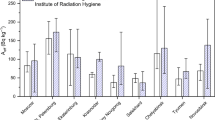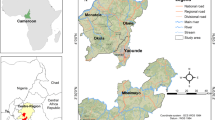Abstract
To control the specific activity of 226Ra in building materials of operated buildings, a non-destructive in situ method consisted in measurements of gamma spectra with a fixed geometry of the detector position in a room is suggested. The calculation of the average specific activity of natural radionuclides in building materials is carried out by comparing the calculated flux density of unscattered gamma quanta normalized to the specific activity of 100 Bq/kg, and the experimentally measured count rates in the photopeak. For the measured values of the average specific activity of 226Ra in building materials, the expected values of radon concentration in rooms were calculated. The developed method has been verified for rooms in modern multi-storey energy-efficient buildings. Concentrations of 232Th and 40K in building materials which contribute to the indoor external radiation exposure can be measured by developed method also.







Similar content being viewed by others
References
UNSCEAR (2006) Sources and Effects of Ionizing Radiation United Nations Scientific Committee on the Effects of Atomic Radiation. United Nations, New York
Nero AV, Nazaroff WW (1984) Characterizing the Source of Radon Indoors. Radiat Prot Dosim 7:23–39. https://doi.org/10.1093/oxfordjournals.rpd.a082958
Nazaroff WW (1988) Entry by pressure-driven flow or molecular diffusion? A reassessment of 222Rn concentrations measured in an energy efficient house. Health Phys 55:1005–1009
Arvela H (1995) Seasonal variation in radon concentration of 3000 dwellings with model comparisons. Radiat Protect Dosim 59(1):33–42. https://doi.org/10.1093/oxfordjournals.rpd.a082634
Levesque B, Gauvin D, McGregor RG, Martel R, Gingras S, Dontigny A, Walker WB, Lajoie P, Letourneau E (1997) Radon in residences: influences of geological and housing characteristics. Health Phys 72:907–914. https://doi.org/10.1097/00004032-199706000-00009
ECA (1995) European Collaborative Action "lndoor Air Quality and its Impact on Man", Radon in indoor air. Report No 15, EUR 161 23 EN. http://www.inive.org/medias/ECA/ECA_Report15.pdf. Assessed 14 Jan 2021
ICRP (1993) Protection Against Radon-222 at Home and at Work. ICRP Publication 65. Ann ICRP 23(2)
Swedjemark GA (1980) Radioactivity in houses built of aerated concrete based on alum shale. Specialist meeting on the assessment of radon and daughter exposure and related biological effects, Rome, 3–8 March 1980. https://inis.iaea.org/collection/NCLCollectionStore/_Public/11/555/11555044.pdf?r=1. Assessed 14 Jan 2021
Swedjemark GA (2004) The history of radon from a Swedish perspective. Radiat Protect Dosim 109(4):421–426. https://doi.org/10.1093/rpd/nch318
Hůlka J, Vlček J, Thomas J (2008) Natural radioactivity in building materials—Czech experience and European legislation. Proceedings of the American Association of Radon Scientists and Technologists 2008 International Symposium Las Vegas NV, Sept 14–17. http://citeseerx.ist.psu.edu/viewdoc/download?doi=10.1.1.371.4443&rep=rep1&type=pdf. Assessed 14 Jan 2021
Thomas J (2020) Prehistory of the Czech radon program. Radiat Protect Dosim. https://doi.org/10.1093/rpd/ncaa164
Vasilyev AV, Zhukovsky MV (2013) Determination of mechanisms and parameters which affect radon entry into a room. J Environ Radioact 124:185–190. https://doi.org/10.1016/j.jenvrad.2013.04.014
Yarmoshenko IV, Onishchenko AD, Malinovsky GP, Vasilyev AV, Nazarov EI, Zhukovsky MV (2020) Radon concentration in conventional and new energy efficient multi-storey apartment houses: results of survey in four Russian cities. Sci Rep 10:18136. https://doi.org/10.1038/s41598-020-75274-4
Zhukovsky MV, Vasilyev AV (2014) Mechanisms and sources of radon entry in buildings constructed with modern technologies. Radiat Protect Dosim 160(1–3):48–52. https://doi.org/10.1093/rpd/ncu111
Yarmoshenko IV, Vasilyev AV, Onishchenko AD, Kiselev SM, Zhukovsky MV (2014) Indoor radon problem in energy efficient multi-storey buildings. Radiat Protect Dosim 160(1–3):53–56. https://doi.org/10.1093/rpd/ncu110
Vasilyev AV, Yarmoshenko IV, Zhukovsky MV (2015) Low air exchange rate causes high indoor radon concentration in energy-efficient buildings. Radiat Protect Dosim 164(4):601–605. https://doi.org/10.1093/rpd/ncv319
Instruments and technologies for nuclear measurements and radiation monitoring, ATOMTEX Product Catalogue. ftp://ftp.atomtex.com/catalogues/catalogue_en.pdf Assessed 14 Jan 2021
Grove Software (2017) MicroShield® User’s Manual. Grove Software, a Division of Grove Engineering, Inc.
UNSCEAR (2000) Sources and Effects of Ionizing Radiation United Nations Scientific Committee on the Effects of Atomic Radiation. United Nations, New York
Yu C, LePoire DJ, Cheng JJ, Gnanapragasam E et al (2003) User’s Manual for RESRAD-BUILD Ver 3 ANL/EAD/03-1. Argonne National Laboratory, Argonne
Treiger SI, Piskunov LI, Smirnov BP (1987) Natural radioactivity of building materials in the Middle Urals. Sverdlovsk (in Russian)
Culot MVJ, Olson HG, Schiager KJ (1976) Effective diffusion coefficient of radon in concrete, theory and method for field measurements. Health Phys 30:263–270
Nuccetelli C, Leonardi F, Trevisi R (2020) Building material radon emanation and exhalation rate: Need of a shared measurement protocol from the European database analysis. J Environ Radioact 225:106438. https://doi.org/10.1016/j.jenvrad.2020.106438
Chauhan RP, Kumar A (2015) A Comparative study of indoor radon contributed by diffusive and advective transport through intact concrete. Phys Procedia 80:109–112. https://doi.org/10.1016/j.phpro.2015.11.066
Rogers VC, Nielson KK, Holt RB (1995) Radon diffusion coefficients for aged residential concretes. Health Phys 68:832–834. https://doi.org/10.1016/10.1097/00004032-199506000-00011
Yarmoshenko I, Zhukovsky M, Onishchenko A, Vasilyev A, Malinovsky G (2021) Factors influencing temporal variations of radon concentration in high-rise buildings. J Environ Radioact 232:106575. https://doi.org/10.1016/j.jenvrad.2021.106575
Yarmoshenko I, Onishchenko A, Malinovsky G, Vasilyev A (2020) Radon time series in four flats in energy efficient multi-storey building. Radiat Protect Dosim 191(2):228–232. https://doi.org/10.1093/rpd/ncaa158
Acknowledgements
The study was supported by Russian Science Foundation (Grant No. 19-19-00191).
Author information
Authors and Affiliations
Corresponding author
Additional information
Publisher's Note
Springer Nature remains neutral with regard to jurisdictional claims in published maps and institutional affiliations.
Rights and permissions
About this article
Cite this article
Yarmoshenko, I., Vasilyev, A., Ekidin, A. et al. Non-destructive measurements of natural radionuclides in building materials for radon entry rate assessment. J Radioanal Nucl Chem 328, 727–737 (2021). https://doi.org/10.1007/s10967-021-07690-3
Received:
Accepted:
Published:
Issue Date:
DOI: https://doi.org/10.1007/s10967-021-07690-3




